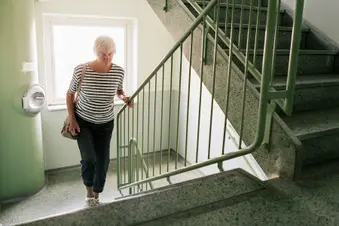
To prevent falls associated with osteoporosis, it is essential to build strength, improve balance, and make minor adjustments at home. Regular exercise, wearing proper shoes, regular eye checks, and maintaining clutter-free spaces can all help reduce the risk of falls and fractures
In the United States, 1.5 million fractures due to falls are reported in people with osteoporosis each year.
Many of these fractures can be avoided if you adopt habits that strengthen your bones and improve your quality of life.
These seven simple actions can help you reduce your risk of falls.
1. Prepare Your Home
Your home should feel safe and give you clear access to every corner. You can lower your risk of falls by:
- Adding good lighting in bedrooms and hallways, especially at night
- Removing slippery rugs and loose cords and arranging furniture for more effortless movement
- Installing grab bars in the bathroom or placing a chair in the shower or tub
- Organizing the kitchen so essentials are within easy reach
- Putting handrails on both sides of the stairs
2. Improve Your Vision
Keep your lenses or glasses clean and wear ones with the correct prescription and protection against sun glare; this helps you see better and reduces the risk of tripping.
It’s also important to visit your eye doctor regularly to ensure your glasses are up to date. Good vision allows you to detect obstacles earlier and move around more safely.
3. Wear Appropriate Footwear
“Supportive footwear is essential when it comes to preventing falls, improving balance, and protecting joints from impact,” says Roselyn Bonilla, MD, a gynecologist at MASF Docs in Miami Springs, Florida.
If you have osteoporosis, choose footwear with:
- A wide base, firm soles, and low heels to keep your foot stable.
- Good arch support and cushioning to absorb impact while walking.
“Avoid wearing footwear such as flip-flops, slippers, or worn-out or slippery shoes; they are not recommended if you have osteoporosis,” Bonilla says.
4. Strengthen Your Balance and Muscles
Balance and weight training exercises are essential for preventing falls. They help you stay stable and work the muscles that support your bones.
This is especially important for people who’ve had a fracture since they’re at higher risk for future falls.
To maintain bone health, you can do the following:
- Weight-bearing aerobic activity, brisk walking, dancing, or using the elliptical.
- Strength or resistance exercises, such as lifting light weights, using resistance bands, wall push-ups, or chair squats.
- Balance and posture exercises that support your spine, such as tai chi, yoga, or Pilates, with modifications that prevent excessive back rounding.
- Flexibility and stretching exercises to improve movement and reduce stiffness.
5. Eat Foods With Protein, Calcium, and Vitamin D
Follow a balanced diet to maintain healthy bones. Some foods you can include are:
- Low-fat or non-fat dairy products, such as milk, yogurt, and cheese, which are rich in calcium.
- Fish with vitamin D, such as canned sardines, salmon, and tuna.
- Proteins that strengthen your muscles, such as lean meats, chicken, eggs, beans, and lentils.
- Fruits with vitamin C, such as citrus fruits, papaya, strawberries, and plums.
- Vegetables with calcium, such as kale, broccoli, collard greens, and okra.
6. Check the Side Effects of Your Treatment
Some medications, including some used to strengthen bones, can cause dizziness, which may increase the risk of falls.
If you experience dizziness, talk to your doctor about adjusting your medication treatment to minimize these side effects.
Some hormones, including anabolic medication used to strengthen bones, may also cause dizziness. Tell your doctor about any side effects that you are having, and they will help find the treatment plan that is safest for you.
7. Avoid Smoking and Drink Less Alcohol
Smoking weakens your bones and increases your risk of fractures.
Research shows chronic, heavy alcohol use, especially during adolescence and young adulthood, can harm bone health and raise the risk of osteoporosis later in life.
Alcohol affects your body in several ways.
- Muscles. It raises the risk of wear and tear.
- Bone density. It makes your bones weaker and increases your risk of fractures.
- Brain. It disrupts communication pathways, making it harder to think clearly and stay coordinated.
Ask for Help
Seeking help is essential to prevent falls related to osteoporosis.
Community and family support can help you organize your home and avoid obstacles that might trip you up.
Communicating with your doctor if you experience symptoms such as dizziness will help determine if medications are the cause and help adjust your treatment to help you maintain your balance.
What Should You Do If You Fall?
Steps to follow if you fall:
- Breathe deeply and try to stay calm.
- If you think or feel as though you have a fracture, call 911.
- If you can slide, try to reach a chair or a stable surface to steady yourself. If you think you can get up without assistance, turn on to your side.
- Rest while your body and blood pressure stabilize.
- Schedule an appointment with your doctor to assess this fall and work to prevent a similar event in the future.
Show Sources
Photo Credit: Maskot/Getty Images
SOURCES:
Roselyn Bonilla, MD, board-certified gynecologist, MASF Docs, Miami Springs, Florida.
Bone Health and Osteoporosis Foundation: “Nutrition.”
International Journal of Environmental Research and Public Health: “Alcohol Consumption, Bone Mineral Density, and Risk of Osteoporotic Fractures: A Dose–Response Meta-Analysis.”
Frontiers: “Assessing fall risk in osteoporosis patients: a comparative study of age-matched fallers and nonfallers.”
International Osteoporosis Foundation: “Prevent Falls.”
National Institute of Aging: “Falls and Fractures in Older Adults: Causes and Prevention.”
National Institute of Aging: “Osteoporosis.”
National Institute of Alcohol Abuse: “Alcohol’s Effects on the body.”
Office of the Surgeon General (US): “Bone Health and Osteoporosis: A Report of the Surgeon General,” “The burden of Bone Disease.”